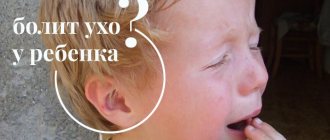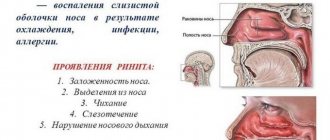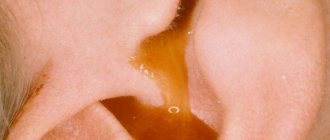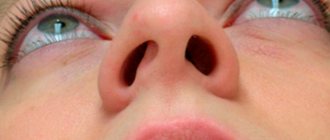New mothers are always worried if they notice that something is wrong with their child. This is especially true for a runny nose in a baby: a completely natural condition greatly worries parents. In some cases, nasal congestion in a small child can be considered normal, but there are also reasons for concern. So, why does nasal congestion occur in infants? And how to treat it?
A stuffy nose in a baby under one month old is normal. The snot flows because the mucous membrane has not yet had time to adapt to the environment. But you should not take this condition calmly: it is better to monitor the baby in order to take action if necessary.
The reasons for this phenomenon are discussed below:
- The nasal passages are too narrow. If the air in the room is too dry, it becomes difficult for the baby to breathe. The nose is clogged, snot is flowing. The baby may even make sounds similar to grunting. What to do in this case? It is necessary to ventilate the apartment more often, paying attention to the room with the baby. A humidifier is required.
A regular water bottle can also replace it. If your nose is still clogged, you need to look for other causes. Treatment may be required. - Allergy. It often occurs in infants because their body has not yet adapted to environmental conditions. Things that are harmless to an adult can cause allergies: clothes, laundry detergents, dishwashing detergents. In this case, an allergic rhinitis occurs. Dust, plants, animal fur, clothing, cosmetics, and perfume can cause snot. In this case, you need to consult a doctor so as not to worsen the situation, but begin treatment immediately. The doctor will prescribe treatment.
- Viral infection. The baby's immune system is still very weak, so it is susceptible to viruses and bacteria. While an adult’s body can resist them, a child’s body cannot do this yet, so it is imperative to treat the baby. Therefore, a viral runny nose occurs. If someone in the family has snot, it can easily be passed on to the child.
This condition is dangerous; the baby may refuse food, not sleep, or be capricious. Treatment is definitely needed. - Snot during teething deserves special attention. This period does not pass unnoticed by parents. Children begin to cry, worry, sleep poorly, and sometimes do not eat. When teething, a runny nose also occurs.
The body is always weakened during teething. Immunity decreases, so the child is exposed to infections. This is why a runny nose often occurs when teething: the defenses are weakened. But snot occurs for another reason.
The gums are supplied with blood, and their structure is connected with the nasal mucosa. During teething, the nasal glands become active, which leads to clear discharge. In this case, a runny nose is a normal condition. It is important to be able to distinguish one snot from another.
If discharge occurs during teething, it always has a transparent tint and passes quickly. If the snot flows for more than 4 days, you need to sound the alarm: there is an infection in the body. Greenish or white copious discharge is a reason to be wary.
Sometimes they dry out: in this case they need to be removed. Parents can help their child with this.
How to treat? When teething, the baby must first clean his nose if there is snot. The nasal passages are then moistened from the inside with a saline solution.
Mucus from the nasal cavity should be removed regularly. Medications that constrict blood vessels can also help.
When teething, such drugs are effective. But you shouldn’t give them yourself: the child may develop allergies. It is better to first consult a doctor and then treat your baby.
How to fix
Treatment of a runny nose in infants is different. This is due to the fact that infants are prohibited from taking some “adult” medications. Treatment must be individualized, so the cause must first be identified. Allergies, viruses, snot during teething - situations that require their own approach, and therefore their treatment is different.
What to do if snot flows heavily? Children's vasoconstrictor medications will help. You should always have them on hand, so you need to go to the pharmacy in advance. A runny nose in infants begins suddenly. These drugs act quickly: they relieve swelling and improve breathing. The baby's condition is improving, which gives both him and his parents a rest.
When giving your baby medications to constrict blood vessels, you need to remember:
- It is better not to use such drugs for more than 3 days;
- It is better to consult your doctor about the dose and frequency. Do not set the dose yourself;
- There is no need to treat very tiny infants with such medications.
The child’s condition does not always require intervention. There are cases when treatment is not required. This was mentioned above: there may be dry air in the room. The problem can be solved with a humidifier and frequent ventilation.
What not to do
Young mothers, having noticed snot in their child, do not always understand how to treat it correctly. Incompetent treatment can only worsen the child’s condition. And some events need to be said “no” altogether. The baby's body is very fragile, so it can easily be harmed by inept washing, as well as low-quality medications.
So, what absolutely should not be done?
- Give your baby antibiotics without a doctor's prescription. Do not instill antibiotic solutions into the nasal passages.
- There is a misconception: when you have a runny nose, you need to put breast milk in your nose. But this will not help: bacteria in the milk environment only multiply.
- Vasoconstrictor drops are used only with the permission of a doctor. This should be done no more than 3-5 days, otherwise the product will be harmful. Infants do not have drops of aloe juice, garlic, or solutions of potassium permanganate dripped into their noses.
These substances burn the mucous membrane and cause irritation. - You cannot rinse your baby’s nose with a syringe or bulb. Such aggressive washing leads to otitis media. Infected fluid can accumulate in the ear cavity and cause irritation as well as inflammation. Do not rinse your nose with large amounts of liquid.
- When teething, the general condition of the child’s body worsens: a fever may appear, the baby sleeps poorly, does not eat, and is capricious. You need to be patient: this period will pass soon.
Prevention
What to do if your baby has a lot of snot and you don’t have the necessary medications on hand? It is better to consult a doctor immediately, since a runny nose quickly becomes a complication.
To prevent this from happening, it is necessary to carry out preventive measures: maintain the desired indoor climate, protect the child from wind and drafts, limit communication with sick relatives, bathe more often, change diapers and underwear. Then nasal congestion will not bother the baby.
If so, then in any case it is necessary to clean it, since the newborn has not yet learned to breathe through the mouth. But there may not be a need for treatment.
Is treatment necessary?
In the first months of a baby's life, nasal congestion is common, as at this time the whole body is still adapting to existence in the environment. If a child sneezes and clear liquid comes out of his nose, there is no need to sound the alarm - specialized treatment and medications are not required.
If your child has a stuffy nose, there are several rules you need to follow:
Avoid visiting crowded places;
During the warm season, stay in the fresh air for at least 5-6 hours a day;
Carry out wet cleaning in the apartment as often as possible;
Protect your baby from contact with sick relatives.
Popular advice about instilling breast milk as a remedy for nasal congestion is a dangerous misconception, since milk is fatty and does not pierce the nasal passage, but, on the contrary, clogs it. In addition, it can easily introduce an infection into the child’s respiratory tract.
If the baby does not eat well, cries often and his body temperature rises, then this may indicate the development of serious diseases - otitis media, sinusitis and others. That's when you definitely need to visit a doctor.
What if your baby's nose is stuffy in the morning?
Parents often notice that the baby “grunts” . However, nothing like this happened during the day.
There is no need to panic, most likely the reason for this is narrow nasal passages; with age, everything will definitely return to normal .
Also, the cause of morning congestion may be dry air in the room or a nearby object to which your child is allergic .
Ventilate the room, remove anything that may cause allergies . To exclude the disease sinusitis, you need to consult a specialist.
How is an ultrasound of the brain done in a baby? Is the procedure safe and what are the normal results? Advice from experienced doctors. Constipation in newborns during breastfeeding - https://mamavika.com/detskoe-pitanie/kormyashhim-mamam/zapor-u-novorozhdennyih-pri-grudnom-vskarmlivanii.html.
How to cure nasal congestion in an infant
The primary goal of parents is to relieve nasal congestion in their child. Typically, vasoconstrictors are used for this, for example, Nazivin. They affect the mucous membrane and restore breathing in the nose. But before you use it for, you must:
Remember that the duration of treatment with such drugs is no more than 3 days;
Be sure to consult your pediatrician in advance.
Inhalations also help relieve congestion. Pour hot water into a deep plate, add a little soda or fir oil. Let him breathe in the fumes for about 10 minutes - the mucus should liquefy. Then
Nasal congestion is a common problem that occurs in children in the first year of life and is of both physiological and pathological nature. Swelling of the mucous membrane, leading to the accumulation of mucus in the nose, prevents the child from breathing, eating and sleeping normally. The baby does not know how to get rid of excess mucus and breathe through the mouth, so he becomes irritable, refuses to eat and often wakes up at night.
You should know that a stuffy nose is a common cause of weight loss in children and lack of oxygen, on which the normal functioning of internal organs and the brain largely depends. Therefore, as soon as you notice that your baby has a stuffy nose, try to identify the cause and eliminate it.
Nasal congestion without a runny nose is a common problem in children, which can be the beginning of a serious illness, so it is strictly forbidden to let it take its course
What to do if your nose grunts?
If a baby has a stuffy nose , you can hear him “grunting” and even snot flowing, this is not an indication that the baby is sick.
There is such a thing as a physiological runny nose - a runny nose that does not require treatment and goes away on its own, associated with teething or the formation of organs. How do you know it's him?
Such a runny nose does not bother the child at all, he may grunt, snot may leak, but the child does not experience any discomfort . Congestion does not prevent the child from eating, sleeping and does not affect his behavior in any way. The main thing is to wipe your nose and drip Aquamaris .
And if, due to nasal congestion, the baby cannot eat, sleeps poorly, is capricious, or the nose does not breathe, this is a reason to start treatment according to the scheme described above, but it is better to consult a pediatrician.
If you suspect nasal congestion, it is important to closely monitor your child and, if an illness is detected, consult a doctor and begin treatment.
Why does a baby have a stuffy nose?
Pediatricians identify several causes of clogged nasal canals:
- Physiological. It is caused by the immaturity of the nasal mucosa in newborns and their irritation by microparticles of wool, dust, drops of milk or formula. By 8-10 weeks of life, the body adapts to the influence of the outside world and the physiological runny nose goes away on its own.
- Allergic. It is expressed in a pathological, hypersensitive reaction of the child’s immune system to any substances: wool, food, pollen, dust. Cure occurs only when the allergen is completely neutralized.
- Dental. It is associated with the peculiarities of the anatomical structure of the mucous membranes of the nose and gums of newborns - their close location relative to each other, as well as weakening of the immune system during the period of active teething. For the most part, it does not require treatment and goes away after the new tooth emerges.
- Infectious. It is considered the most dangerous, as it is fraught with serious complications for a fragile body. It is caused by the penetration of bacteria and viruses transmitted by airborne droplets into the child’s body. Requires comprehensive treatment and protecting the child from contact with carriers of the infection.
In rare cases, congestion of the nasal passages is explained by a congenital curvature of the nasal septum, a foreign body entering the nose and drying out of the nasal mucosa due to insufficient humidity in the room.
In addition, the excessive sterility of the room in which the newborn is located and its maximum isolation from the outside world subsequently entail the inability of the child’s immune system to fight microorganisms attacking it.
Signs and causes
The situation when, after giving birth, a mother notices with alarm that the child’s nose is not breathing is not uncommon. To properly treat a runny nose, it is important to determine its cause:
- Physiological rhinitis. In most cases, this condition is not a pathology and is explained by the structural features of the nose of babies under one year old and the narrowness of the nasal passages. The mucous membrane is not fully formed. Therefore, a newborn and even a month-old baby breathes poorly. At this stage, there may be slight mucous discharge and swelling of the nasopharynx. This is the norm. Physiological rhinitis can be distinguished from a cold by the discharge. With a cold, it is liquid, constantly flowing snot, turning into thicker ones. A baby with a cold completely loses the ability to breathe through the nose, while with physiological rhinitis, even when swelling of the mucous membrane develops, the ability to breathe through the nose is partially preserved.
- Insufficiently humid air in the room, which leads to drying of the secretion on the mucous membrane. The resulting crusts cause the child to suffocate, begin to sniffle, and breathe heavily through his nose.
- Clothes that are too warm or the temperature is too high can cause the baby to sweat and overheat. As a result, immunity decreases and a viral infection develops, accompanied by a runny nose. The newborn is suffocating and cannot breathe through his nose.
- Teething. This process involves not only the oral mucosa, but also the nasal mucosa. It becomes inflamed and swollen. The situation when a baby wakes up from nasal congestion while teeth are growing and becomes capricious is familiar first-hand to every mother.
- Sensitivity of a newborn to the action of allergens, including dust, pet hair, feathers, fluff of pillows and blankets, mites, detergents, washing powders, pollen. Therefore, parents should be very responsible about the cleanliness of the children's room and try to protect the baby from contact with irritants.
- Congenital anomalies of the nasopharynx, leading to partial or complete obstruction. Such pathologies are extremely rare.
- Adenoiditis. Inflammation of the pharyngeal tonsil in infancy is an isolated phenomenon. This may be due to infections or allergens.
- Complications after viral and bacterial infections. Most often, infants experience inflammation of the ethmoid bone (ethmoiditis) and the maxillary sinuses (sinusitis).
Diseases accompanied by nasal congestion
All diseases that cause nasal congestion can be divided into 2 categories: with abundant nasal mucus (muconasal secretion) and without snot, which is often a more dangerous and alarming symptom of ENT diseases. To make an accurate diagnosis, vigilant parents should consult an otolaryngologist, allergist, therapist and immunologist.
Profuse flow of snot is typical for:
- Acute rhinitis. As a result of hypothermia and weakened immunity, microbes and viruses penetrate the body, causing irritation and inflammation of the mucous membrane. Most often, a runny nose is a symptom of acute respiratory infections and flu and is accompanied by copious watery discharge, itching, lacrimation and fever.
- Chronic rhinitis. It is a consequence of recurrent untreated acute rhinitis and uncontrolled use of vasoconstrictor drops. It is characterized by constant nasal discharge and congestion, a nasal voice, and a persistent lack of smell.
- Allergic rhinitis. It occurs as a response of the immune system to irritants - allergens. It can be either seasonal or chronic. Manifested by lacrimation, sneezing and copious nasal mucus. After eliminating the allergen, the patient recovers completely.
To determine the exact cause of nasal congestion, the child should be shown to an experienced pediatrician.
Nasal congestion without snot is most often accompanied by the following diseases:
- Sinusitis. It is a serious complication of infectious diseases and is characterized by purulent inflammation of the paranasal sinuses due to stagnation of the secretions of the nasal canals. Otolaryngologists classify sinusitis as sinusitis, frontal sinusitis, sphenoiditis, and ethmoiditis.
- Adenoiditis. It is characterized by pathological proliferation of lymphoid tissue covering the nasopharynx. With adenoiditis, the child constantly breathes through his mouth, may snore in his sleep, cough and often gets sick.
- Congenital pathologies of the nasopharynx. There is a disruption in the functions of organs associated with the secretion and removal of muconasal secretions.
Consequences for the child
Often, nasal congestion is not perceived by parents as a serious threat to the child’s health. However, it should be remembered that prolonged sinus congestion increases the risk of diseases of the lower respiratory tract - bronchi and lungs.
Constantly inhaling air through the mouth dries out the mucous membranes, tongue, and oral cavity, which causes inflammation of the nasopharynx and bad breath.
In addition, the air consumed through the mouth is not enough to provide organs and tissues with the optimal amount of oxygen. As a result, the brain experiences oxygen starvation (hypoxia), the respiratory rate increases, leading to depletion of the respiratory center, and the heart rate increases, increasing blood pressure and the load on the cardiovascular system.
Treatment regimen
Parents should be wary if their one-month-old baby has problems breathing freely for more than a week. Diagnosis of nasal congestion in children should only be entrusted to a professional. At home, to alleviate the baby’s general condition, you can do a number of medicinal procedures: instill physiological/saline solutions into the nasal sinuses (Aqualor Baby, Marimer, Aqua Maris, Physiomer) and, if necessary, use vasoconstrictor drops (Nazivin, Nazol Baby). Among the traditional methods, onion drops and chamomile decoction have proven themselves to be effective.
Whatever treatment you choose, you should remember that rinsing a newborn’s poorly breathing nose with sprays is strictly prohibited due to the close proximity of the nasal passages and the Eustachian tube. This is fraught with the reflux of mucus into the ear canal and the development of otitis media. In addition, long-term (longer than 3-5 days) uncontrolled use of vasoconstrictor drops causes the nasal tissues to become accustomed to the temporary positive effect of relief, and they cease to fully perform their functions.
Prevention
It is easier to prevent a disease than to deal with its consequences. What to do to prevent nasal congestion? Pediatricians recommend the following:
- clean the baby’s nose daily with cotton pads;
- regularly ventilate the child’s room and carry out wet cleaning;
- maintain an optimal level of air humidity in the apartment;
- organize walks with your child, choosing places with the least crowds of people;
- avoid contact with infected people;
- carry out hardening procedures.
A stuffy nose in a newborn baby is a huge problem for both the baby and his parents. After all, during feeding, the baby breathes exclusively through his nose, and when the nasal passages are blocked, the baby has to breathe through his mouth.
In addition, mothers almost always begin to panic, believing that the baby is sick. But nasal congestion in infants during the first three weeks of life is a physiological norm. This pathological condition is explained by the fact that its mucous membrane adapts to new environmental conditions. This is why babies have a stuffy nose very often.
When you need specialist help
Usually, mild nasal congestion in a baby does not require contacting a pediatrician. But medical attention is necessary if the following symptoms appear:
- whistling sounds when the baby breathes;
- red throat in addition to a runny nose;
- loss of appetite;
- weight loss;
- blood from the nose;
- deviations in body temperature in a child from 3 months to six months in one direction or another;
- observed for more than 7 days.
In this case, you should consult your doctor.
Baby sprays – collage
» data-medium-file=»https://i0.wp.com/nasmork.guru/wp-content/uploads/2017/11/nasmork-nr-sprei.png?fit=600%2C271&ssl=1″ data- large-file=”https://i0.wp.com/nasmork.guru/wp-content/uploads/2017/11/nasmork-nr-sprei.png?fit=640%2C289&ssl=1″ > Children's nasal sprays
The most common causes of nasal congestion in newborn babies
The causes of nasal congestion in babies who are not yet one year old can be excessively narrow nasal passages. And then it is difficult for the child to be in a room with too dry air. In this case, the baby’s nose is constantly stuffy and he “grunts.” And if no ventilation or artificial humidification of the air helps the baby, and the secretion of mucus is added to the state of congestion, then the problem here is different.
The most common causes of a runny nose in a baby are either an allergy or the presence of a viral infection.
- A long course is typical for allergic rhinitis. At least until the moment when the source of the allergy is eliminated. Allergens can be the fur of cats, dogs, birds and other living creatures that live in the apartment as pets, household chemicals, household dust or pollen.
- A viral runny nose is a consequence of the development of an infection that was “shared” with the child either by one of the relatives or by guests who visited the baby. That is why visits from strangers in the first months of a baby’s life should be limited.
But in any case, a stuffy nose becomes a huge problem for babies. The baby is very worried, sleeps and eats poorly.
In some cases, a runny nose may accompany the appearance of teeth. And rhinitis goes away with the appearance of a new tooth.
What to do to combat the disease?
Having discovered nasal congestion in a baby, you need to determine what is causing it and what its nature is .
Only after this should treatment begin. Methods of dealing with congestion depend on the specifics of nasal congestion .
If your baby has a stuffy nose, snot is running, and you determine that it is a virus, you should consult a doctor. The main methods of control will be vasoconstrictor drops (Nazivin, Otrivin, Nazol, etc.). You can drip them 3-4 times a day, no more than 3 days every time. Nazivin can be increased to 5 days, but only if it really suits your baby .
Why does constipation occur in newborns who are bottle-fed? All the nuances. Now let's take a closer look at the reasons why a baby grunts through its nose, but there is no snot.
Why a baby can’t go to the toilet, read here in our article. Advice from pediatricians.
A runny nose can be treated with Protargol drops. These drops are prepared directly at the pharmacy; be sure to tell the pharmacist the age of the baby, since the dosage is different .
These drops can be used for no more than 7 days and stored in the refrigerator. If the baby is very few days old, it is better not to drip them, but to smear them in the nose.
Aquamaris drops, which are not at all harmful to newborns, will help ease breathing. They liquefy and rinse the spout . In general, it is recommended to drip them before vasoconstrictor drops (but this can be difficult to do, since children are very resistant when someone wants to drip something into them).
If the drops do not help the child, the congestion does not subside, the snot flows, and the child cannot breathe, a nasal aspirator .
It is a silicone or rubber tube. suck out the accumulated mucus through it .
It is worth understanding that there is a possibility of infection in adults. There are also electric aspirators for children.
If a baby has a stuffy nose, he grunts, but there is no snot, nothing needs to be treated, it is worth creating comfortable conditions for the baby.
Humidify the air in the apartment. If it is not possible to purchase an air humidifier, you need to hang wet diapers on the radiators (during the heating season) and change them in a timely manner.
Ventilate the room . Fresh air is important for babies and promotes proper breathing, remember and follow this.
Get rid of things that can cause allergies for a while. It is recommended to occasionally drip Aquamaris onto your baby , thereby moisturizing the nasal mucosa.
The following areas of nasal congestion can be distinguished, the treatment of each depends on the specific type of childhood disease.
Other probable causes of nasal congestion in infants
Nasal congestion can also be caused by:
- Dry air in the room where the baby sleeps. This condition especially often develops in a child with the beginning of the heating season. Try a damp towel in the room in the evening and if in the morning the baby’s nose breathes freely, then the problem is precisely insufficient air humidity.
- The presence of an allergen in the room.
- The development of such a complex disease as sinusitis in a child. At the same time, the baby can breathe freely through his nose throughout the day, but in the morning he always wakes up with a stuffy nose. In this case, the child must be shown to a doctor and receive advice.
- Nasal congestion in infants at night is caused by increased production of nasal mucus.
- Chronic nasal congestion requires special attention. We can talk about the development of this condition in the case when the child does not have free nasal breathing for 1…2 months. At the same time, the baby’s nose remains stuffy all the time. Only a specialist can establish the true cause and make an accurate diagnosis.
Worth taking note! If a child’s nose is simply stuffy as a result of swelling of the mucous membrane, but there is no nasal discharge, then the reason for this is that the air in the room where the child is is too dry. Separation of mucus of varying intensity with nasal congestion is a clear sign of a viral runny nose.
Is it a runny nose in the baby?
When a mother notices that the child has a stuffy nose, the baby is “grunting” through his nose, sleeping poorly, the first thing that comes to mind is that the baby has a cold and has a runny nose. But the absence of free nasal breathing does not always indicate a runny nose.
There are a number of reasons why your nose may be stuffy:
- overdrying of the mucous membrane of the upper respiratory tract due to dry air in the room;
- allergic reaction and swelling of the mucous membrane;
- foreign body in the upper respiratory tract;
- disruption of the discharge of mucous secretions (snot) due to the physiological characteristics of the structure of the upper respiratory tract.
The cause can be determined and eliminated only with the help of a pediatrician and by properly following the recommendations.
Treatment of the disease
If the cause of congestion is dry air in the room where the baby sleeps and spends most of his time, then this factor must be eliminated. You can increase air humidity by frequent ventilation or by installing a humidifier.
How to treat nasal congestion in a baby if it is accompanied by mucus discharge?
There are several methods here:
- The most effective remedy is vasoconstrictor drops. But such drugs can only be used as prescribed by a doctor, since in most cases the use of such drugs in children under two years of age is prohibited.
- Quite often, infants are prescribed nasal rinsing with saline solutions. For infants, such drugs are produced in special containers with a dispenser, which makes the procedure easier for both mother and baby.
- To clear the nasal passages of mucus, it is recommended to use aspirators. Products come in several varieties. Previously, ordinary rubber bulbs equipped with silicone tips were used, but they have long been the most dangerous. It is very easy to damage the delicate mucous membrane with the tip. When using a mechanical aspirator, the mother sucks out the mucus. Electronic aspirators are more advanced and easier to use - devices that start working after pressing a button. A vacuum aspirator can quickly clear your baby’s nose of accumulated mucus.
Quite often, mothers try to treat nasal congestion in infants using folk remedies. Help relieve nasal congestion:
- Instillation of diluted beet or carrot juice into the nose. But it is worth remembering that beet juice can cause quite a strong burning sensation.
- Fresh aloe juice also helps a lot, but when instilled, the product will flow down the walls of the nasopharynx. And the child may really not like its bitter taste.
In no case should you use breast milk for instillation into the nose to relieve congestion in a baby, as some folk recipes advise. It will only worsen the situation, creating a comfortable living environment for bacteria.
Solutions (oil only) of vitamins A and E can be instilled into the nose. They help not only moisturize dry mucous membranes, but also help strengthen them.
Treatment and prevention of nasal congestion
General recommendations to help cope with nasal congestion in a child:
- It is necessary to raise the head of the crib or playpen with a pillow. The baby himself will help determine the height of the rise when he is comfortable sleeping.
- Instillation of saline solution is allowed from the moment of birth, therefore, to moisturize the nasal passages, it is permissible to use 1 drop in each nostril several times a day. In this case, you need to make sure that the baby does not have allergies.
- An oily solution of vitamin A or E works well to relieve swelling of the nasal passages. For this, it is possible to use an aroma lamp.
- To improve the condition, you can rub the baby’s heels and chest with goat or badger fat. On the heels there are a large number of points associated with the ENT organs. These drugs may cause allergic reactions, so you should consult your pediatrician before use.
- A decoction of chamomile helps relieve nasal congestion. To do this, it is necessary for the baby to inhale the vapors of the healing decoction.
- In the acute form of the disease, it is possible to use vasoconstrictor drops, which are prescribed only by a pediatrician.
- You should not take your baby with you to places with large crowds of people, which can lead to illness, especially a runny nose.
- Children under three years old should not be given nasal rinses with a syringe or bulb.
- You should not put breast milk in your nose, which serves as a breeding ground for bacteria.
Source
Possible consequences of nasal congestion in infants
If a baby has a stuffy nose, it is necessary to get qualified advice as soon as possible. This condition cannot be ignored, since rhinitis in a newborn baby can cause various complications.
With a stuffy nose, the child breathes through his mouth. At the same time, all pathogenic bacteria freely penetrate into the baby’s body, since the natural purification of the air, which is ensured by a healthy nasal mucosa, is “turned off.” That is why a slight runny nose in a baby can result in a cough and more serious inflammation of the upper respiratory tract.
In newborn babies, due to its special anatomy, the nasopharynx is connected to the inner ear. A runny nose can trigger the development of inflammation of the middle ear. This is a very serious condition for a child and should not be forgotten.
Therefore, if even a slight runny nose appears, the baby should be shown to a doctor, who will prescribe a treatment regimen, selecting medications adequate to the condition. It is advisable to avoid self-medication, since incorrectly selected medications can only worsen the child’s condition.
Children under one year of age breathe primarily through the nose, so congestion can cause serious complications. What to do if your baby has a stuffy nose? To select the appropriate drugs for treatment, you need to determine the cause of obstruction of the nasal canals. It should be understood that a child may experience physiological rhinitis in the first two to three months of life, which does not require drug treatment.
Therefore, before using any pharmaceutical medications, it is advisable to show the newborn to a pediatrician. Difficulty in nasal breathing in infants may be a manifestation of allergic, viral or bacterial inflammation of the nasopharynx. This publication will discuss effective methods for treating rhinitis and nasopharyngeal obstruction (obstruction) in young children.
What to do if a newborn has a stuffy nose, but no snot
If nasal congestion persists for some time and causes noticeable discomfort to the baby, it needs to be treated. But a mother who is not a doctor should not try to do this on her own. The right decision in this case is to consult a pediatrician, who will diagnose the cause and tell you how to treat the baby. If this is not done in a timely manner, complications may develop. When a baby cannot breathe through his nose, you can alleviate his condition with the help of:
» data-medium-file=»https://i0.wp.com/nasmork.guru/wp-content/uploads/2017/11/nasmork-nr-turundochki.jpg?fit=600%2C448&ssl=1″ data- large-file=”https://i0.wp.com/nasmork.guru/wp-content/uploads/2017/11/nasmork-nr-turundochki.jpg?fit=640%2C478&ssl=1″ > How to make turundas for nose
What to do when a 6-month-old baby has a stuffy nose. The treatment algorithm at this age, as in newborns, depends on the cause that led to difficulty breathing. Rinsing the nose with saline solutions, humidifying the air and walking outside do not lose their relevance if the child’s nose is not breathing. At this age, the pediatrician, if necessary, can expand the list of medications for the treatment of congestion. Vasoconstrictor, antiviral and antibacterial drops may be prescribed.
A runny nose in such babies quickly leads to complications. Therefore, you should not self-medicate.
Adequate therapy can only be carried out by a doctor after examining the baby and diagnosing the cause of difficulty breathing.
Therapy methods
The occurrence of rhinitis in babies in the first 3 months of life does not always indicate the development of a respiratory disease. At this age, the mucous membranes of the ENT organs are not yet able to fully perform their functions. In particular, the work of the nasopharynx is poorly regulated, so nasal secretions in the nasal cavity can be produced in large volumes for no apparent reason.
It should be understood that in children under 6 months of age, the airways are still too narrow, so nasal secretions can stagnate in them and interfere with normal breathing. Simple physiotherapeutic procedures aimed at removing mucous secretions from the nasopharynx will help eliminate nasal congestion.
Medications
Before treating nasal congestion in an infant, you need to accurately determine the cause of the obstruction of the nasal passages. Infectious inflammation is eliminated by taking antibiotics and antivirals. If the nasopharyngeal obstruction was caused by allergies, your pediatrician will recommend safe antihistamines and nasal barrier products.
You cannot give your child regular pharmaceutical medicines for colds. This is especially true for antibiotics and vasoconstrictor drops (decongestants). They contain too many active ingredients that can cause an allergic reaction in a newborn. As a rule, treatment of nasal congestion in infants involves the use of gentle nasal preparations based on isotonic solutions, as well as immunostimulants and 4th generation antihistamines.
Physiotherapeutic activities
What to do if the baby does not breathe through his nose? Nasal congestion is most often a consequence of overactivity of single-celled mucus-producing glands. Due to the narrowness of the airways, nasal secretions clog the internal nostrils (choanae), through which air penetrates directly into the laryngopharynx. To restore normal patency of the respiratory tract, it is recommended to periodically remove accumulated secretions from the nasal cavity.
If the child is 3 months old, he will not be able to blow out the mucus on his own. To remove fluid from the nasal passages, it is recommended to use nozzle ejectors (aspirators). For the most effective suction of mucus, doctors advise using electronic devices. They are equipped with fairly powerful compressors that allow you to remove nasal secretions in literally a matter of seconds.
If syringe aspirators are used incorrectly, there is a risk of damage to the delicate mucous membrane in the nasal passages.
How to restore nasal breathing in a baby?
If a newborn has a stuffy nose, you need to contact a pediatrician who will conduct an examination and explain what to do to eliminate the obstruction of the nasal passages.
In the case of physiological rhinitis, medications are not used. It is necessary to ensure evacuation of exudate using an aspirator. Before using the device, you should carefully study the instructions so as not to damage the baby’s delicate mucous membranes. A few minutes before the procedure, it is recommended to instill 2-3 drops of an isotonic solution such as Aqualor Baby. The drug will thin the mucus and soften the crusts, which will increase the effect of aspiration.
Another way to make nasal breathing easier is to rinse with cotton wool. Flagella are rolled out of cotton wool, soaked in clean water or 0.9% NaCl solution and placed in the nasal passages, after which they are removed with rotational movements along with clots of mucus.
The importance of nasal breathing in a child under one year of age is invaluable. This is due to the fact that it plays a huge role in the proper development and growth of the baby.
- The child is not physiologically adapted to breathing through the mouth. This phenomenon occurs due to the fact that up to 6 months it is difficult for a child to move air through the mouth due to the tongue pushing the laryngeal cartilage back. Because of this, prolonged breathing through the mouth can lead to hypoxia, which causes a disruption in the overall development of the baby’s body.
- If the nose is stuffy at 5 months, oxygen deficiency provokes an increase in intracranial pressure and a failure of the most important functions of the central nervous system. If a baby has a stuffy nose, he begins to be constantly capricious, and he also experiences sleep disturbances.
- When a newborn has a stuffy nose and the mucous membrane is inflamed, the processes of reproduction of pathogenic microflora are activated. As a result of such a disorder, ENT complications may develop, for example, an inflammatory process in the middle ear, paranasal sinuses, and adenoids.
Also, nasal congestion in infants leads to weight loss. This is due to the fact that the baby is not able to suckle continuously, he is often interrupted, his behavior becomes restless. Lack of weight in a baby leads to the development of even more dangerous complications.
Creating comfortable conditions
If, you need to take care of creating the necessary microclimate in the room. Nasal secretions have a high viscosity, so they often stagnate in the airways and create barriers to the passage of air. To reduce its viscosity, it is recommended to humidify the air using humidifiers or towels hung in the room.
Important! The air humidity in the room should be approximately 60 - 70%.
You can alleviate the symptoms of the disease by following these recommendations:
- Drink plenty of fluids. Lack of moisture in the body automatically increases the viscosity of nasal secretions. To improve the child’s well-being and normalize breathing, it is recommended to feed him milk every hour and a half. If the baby is more than six months old and has already tried natural compotes and juices, you can increase the amount of liquid consumed by about 1/3;
- Wet cleaning. Household dust only increases swelling in the nasopharynx, so during the period of intensive treatment of a baby, it is recommended to do wet cleaning at least 2 times a day. In addition, pediatricians advise removing all “dust collectors” from the nursery - carpets, soft toys, woolen blankets, etc.;
- Regular ventilation. In case of infectious inflammation of the ENT organs, it is necessary to ventilate the children's room at least 3-4 times a day. To disinfect indoor air, you can place cloves of garlic and onion, which contain a large amount of phytoncides, on the windowsills.
Dehydration during illness poses a serious threat not only to the health, but also to the life of the newborn. A one-month-old baby suffering from nasal congestion may refuse to breastfeed. The fact is that children under 5 months breathe primarily through their mouths, so sucking on the breast interferes with normal breathing. If your baby is naughty and refuses to eat, try feeding him with a spoon or syringe.
How to clear your nose?
Babies at 2 months old have very narrow nasal passages, so mucus accumulates in them quickly. It is the anatomical features of the structure of the nasopharynx that most often cause disruption of normal breathing. In cases where a newborn’s nose cannot breathe, pediatricians recommend mechanical cleaning of the nasal cavity, which is carried out in several stages.
Instillation of saline solution
In order for the child to be able to breathe freely through his nose, the airways need to be cleared of mucus. You can reduce its viscosity with the help of isotonic preparations that contain sea salt. The solutions are not addictive and do not irritate the mucous membrane, so they can be used to moisturize it.
Pediatricians recommend using regular saline solution (“Sodium Chloride”) or “Aqua Maris Baby” as a thinning drug. Simply lay your baby on his back with a small towel cushion under his head. Then drop 2-3 drops of the drug into each nostril.
It will not be possible to wash mucus from the nasopharynx by injecting saline under pressure. During the procedure, viscous secretions can penetrate the paranasal sinuses and cause inflammation in them. That is why doctors advise using only pipettes for instilling drugs into the nose.
Suctioning liquid with an aspirator
Approximately 5-7 minutes after the administration of the isotonic solution, the newborn’s nose will be clogged with liquefied mucus. It can be removed using a mechanical or electronic aspirator. To prevent damage to the mucosa, several important points need to be taken into account during the procedure:
- take the newborn in your arms (vertically);
- carefully insert the tip of the aspirator into the nostril;
- turn on the compressor and suck out the mucus from the nasopharynx;
- Clean the second nostril from nasal secretions in the same way.
When using a bulb aspirator, the tip is inserted into the nose only when the bulb is pressed.
If you did everything correctly, the newborn will begin to breathe through his nose immediately after the procedures. You will have to cleanse at least 4-5 times a day during an exacerbation of an ENT disease. After each use of the aspirator, all parts of it that came into contact with mucus should be washed with soapy water or Chlorhexidine.
Cleansing the nasal passages with turundas
Very often, an infant has a stuffy nose due to the formation of dense crusts in the nasal canals. They can appear either independently or after removing the mucus. In this case, the congestion can only be removed mechanically:
- twist a small piece of cotton wool into a narrow flagellum at least 6 cm long;
- moisten one end of the turunda in saline solution or boiled water;
- carefully insert the turunda into the nasal canal, rotate and remove;
- To clean the second nostril, make a new cotton swab and repeat the procedure.
Important! You should not clean your child’s nose with cotton swabs, as they can injure the mucous membrane.
When your baby has a stuffy nose, you will have to perform the procedure every day until nasal breathing is completely restored. It should be understood that crusts in the nose are formed due to low humidity in the room. To improve the quality of inhaled air, it is recommended to use humidifiers or wet sheets and towels hung on radiators.
A baby has a stuffy nose - what to do and how to help a baby
The smaller the child, the more worried the mother is about problems with his health. Nasal congestion in infants causes particular panic. After all, it is difficult to explain to a newborn that you can breathe through your mouth, and it is generally impossible to watch how the baby suffers while eating. The anxiety is also heightened by the fact that parents often do not understand why their child’s nose is clogged and what to do about it. Therefore, in this article we will talk about what can cause nasal congestion, how to clean it, and how to cure a runny nose.
Causes of nasal congestion
The most basic and common cause of nasal congestion in infants is the anatomical structure of its nasal passages. Due to the fact that the baby’s entire body is not yet fully developed, the nasal passages also have vulnerable spots. The thing is that mucus in narrow passages tends to accumulate quickly and drain slowly. Therefore, the baby’s nose quickly becomes clogged, and he cannot breathe fully.
In addition, one more anatomical feature can be highlighted. For the same reason (narrow nasal passages), it is easier for a newborn baby to get swelling of the nasopharynx when cold air enters it. After all, the excess mucus contained in the nose is an excellent place for the growth of various microbes and bacteria. Therefore, in addition to a clogged nose, the baby also gets a runny nose.
Viruses and infections can cause nasal congestion in a baby. But in this case, most likely, the presence of a number of other symptoms - fever, cough and greenish snot. Therefore, if you observe all of the above in your baby, then you should think about treatment. Indeed, due to the fact that all the baby’s passages are in close proximity, inflammation quickly grows, causing not only breathing problems, but also more serious complications (sinusitis, otitis media, etc.).
And the last reason why the baby is deprived of the opportunity to fully breathe through his nose is an allergic reaction. Infants tend to react to everything that surrounds them, and it is impossible to achieve sterility. Therefore, the baby can inhale dust, animal hair, or pollen from plants and trees, and the baby’s nose will respond with swelling of the mucous membrane. In this case, the temperature rarely rises, but the child’s condition noticeably worsens. Lethargy, lack of appetite and irritability - all this is a consequence of oxygen starvation. In the most severe cases, Quincke's edema may develop, when the baby will not be able to breathe at all.
Cleaning the spout
If a newborn baby’s nose does not breathe, then he needs to be treated. This does not always mean the use of medications, because in most cases you can get by with means such as sea water. But the most important thing to note is that it is better not to treat a runny nose, but to prevent it. To do this, you just need to make it a rule to care for your child’s nasal passages every day and do simple manipulations to clean the nose. You will need:
- cotton wool;
- clean water at room temperature;
- sea water.
From cotton wool you need to roll flagella - turundas. Every mother can do this. Then you need to moisten them in water and “screw” them into the baby’s nose. Then moisten the cotton wool with sea water and insert it into the nasal passages again. There is no need to be afraid of causing pain or injuring the mucous membrane. After all, the cotton wool is very soft, and the only thing that can cause a child to protest. Therefore, be prepared for the fact that the baby will in every possible way interfere with you in carrying out this procedure. The only thing worth remembering is that there should be a different cotton swab for each nostril.
What to do if your nose is clogged
If the baby’s nose is tightly clogged, then simple cleansing is no longer enough. Therefore, you will have to use a set of measures to treat your baby. In this case, it would be correct to mention the method proposed by Dr. Komarovsky. It consists of frequent rinsing of the nose and creating a comfortable temperature and humidity in the room.
You can treat a clogged nose in a baby using salt water (Dolphin, Aquamaris, etc.). Today in pharmacies there are a number of drugs in different forms of release - drops, shower and spray. For a newborn baby, it is advisable to choose drops, since only they can be safely used in children under one year of age. Sprays and showers can cause mucus to penetrate deep under a sharp pressure and cause inflammation of adjacent organs.
Treating a newborn with sea water is not difficult. To do this, you need to prepare drops, cotton wool and an aspirator (nozzle pump).
- Place the baby on your lap.
- Place 1-2 drops of salt water into each nostril.
- Wait a couple of minutes for the water to thin the mucus.
- Clean your baby's nose with an aspirator.
In some cases, the use of vasoconstrictor drugs is recommended. They can also be purchased at the pharmacy, depending on the age of the baby. In addition, mothers can use antiseptic drugs (Miramistin, etc.), which should be instilled after cleansing the nose, but before instilling cold remedies. Usually a runny nose can be cured in 5-7 days. But if after this period the child does not show improvement, then you should consult a doctor in order to avoid complications such as sinusitis and otitis media.
Aromatherapy can be used to prevent a runny nose and in addition to the main treatment. To do this, place containers of boiling water around the house, into which you need to add a few drops of chamomile, pine needles or mint oil. This method will not only “break” the baby’s nose, but also normalize the level of humidity in the room.
The older generation, especially grandmothers, advise treating nasal congestion in infants with warming. To do this, it is suggested to use hot salt in a bag, boiled eggs, etc. But such manipulations are not suitable for every case and cannot be done at high temperatures. Such “warming” of the nose can only lead to an increase in the area of inflammation.
If your newborn can't breathe through his nose at all, don't panic. Just remember all the tips and start taking action. The more often you rinse your baby's nose, the faster he will be able to breathe normally. This means it will be good to eat, sleep and enjoy life.
(1 votes, rating: 1.00 out of 5)
RazvitieRebenka.info
Pharmacy drugs
How to treat a newborn if his nose is stuffy? Most drugs that are used to treat rhinitis in adults are not suitable for children. You can relieve congestion in the youngest patients using gentle products that contain a minimum amount of active ingredients:
- vasoconstrictor drops (“Naphthyzin 0.01%”, “Otrivin Baby”) - reduce swelling and normalize the patency of the nasal canals;
- moisturizing drops (“Aqua Maris Baby”, “Quix”) - prevent drying out of the mucous membrane and the formation of dry crusts in it;
- antiseptic drugs (“Albucid”, “Protargol”) - kill bacteria and fungi, thereby reducing inflammation in the nasopharynx;
- immunostimulating drugs (Viferon, Genferon-Lite) - increase resistance to infection, which helps improve health;
- antihistamines (“Cetirizine”, “Fenistil”) - eliminate allergic manifestations, relieve swelling and nasal congestion.









